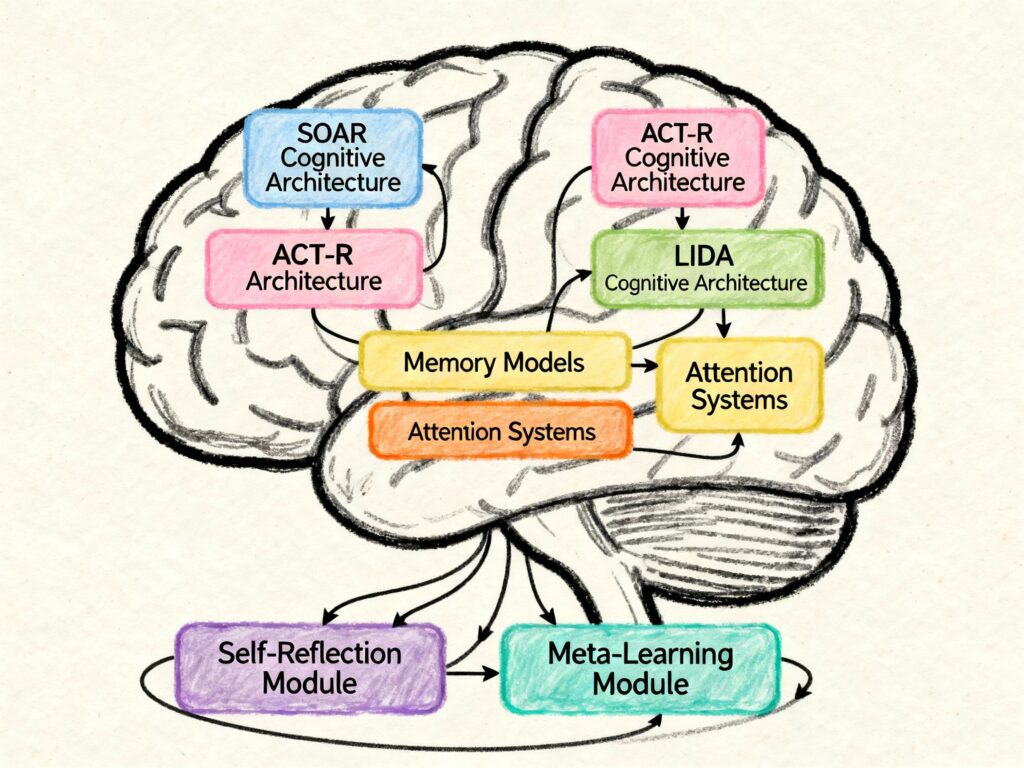Artificial General Intelligence (AGI) is constructed differently from traditional AI systems. Because traditional AI focuses on a single task, like translating text, generating images, or predicting prices, but, on the other hand, AGI needs an internal structure that works more like a human mind.
AGI observes the world, understands new situations, stores long-term memories, learn from mistakes, and even questions its own decisions.
AGI architecture brings together several important components:
- Cognitive architectures (SOAR, ACT-R, LIDA)
- Memory models & attention systems
- Self-reflection and meta-learning

Artificial General Intelligence is the flow of human intelligence, like:
sensing → understanding → reasoning → learning → improving.
This design allows AGI to adapt in new environments, handle unfamiliar tasks, and behave more intelligently over time. In simple words, AGI architecture is like the blueprint of an artificial mind. It describes how the system thinks, how it remembers, how it learns, and how it understands itself.
What Are Cognitive Architectures (SOAR, ACT-R, LIDA) In AGI?
Cognitive architectures are the mental blueprints, like a human, that help an AGI think, remember, learn, and make decisions, similar to how the human brain uses different mental processes.
We know that humans depend on perception, memory, reasoning, and attention. But an AGI needs a structured system that brings all these abilities together, and the cognitive architectures provide that structure.
This method acts as the foundation of an AGI’s intelligence, which defines how it understands the world, stores and retrieves knowledge, solves problems, adapts and learns from new situations.
Think of them as the operating systems for intelligence; each architecture has a different philosophy of how thinking should work.
Let’s learn three most cognitive architectures in AGI research: SOAR, ACT-R, and LIDA.
a) SOAR – The Problem-Solving Thinker
The SOAR working process is similar to humans who are trying to solve a problem step by step. It first decides what it wants to achieve and then checks which actions can help to reach that goal.
Whenever it gets confused or stuck, so it doesn’t stop. Instead, it creates a small temporary goal (sub-goal) to move forward, exactly same like humans do when breaking big tasks into smaller parts.
SOAR always remembers which techniques worked earlier, so next time, whenever it faces a similar situation, it uses its past learning to reach the solution faster. In simple words, it makes a plan like a human and then uses that strategy for different tasks.
b) ACT-R – The Human-Mind Simulator
ACT-R stands for Adaptive Control of Thought – Rational. It’s a cognitive architecture that works naturally, similar to the human brain.
Imagine an AGI not only calculates, but it thinks like a person, using the memory, attention, habits, and rules.
How ACT-R Works In AGI?
ACT-R divides its thinking into different “modules,” then each module handles one mental skill. For example, it has 4 modules:
- Goal Module – What am i trying to do right now?
- Memory Module – What have i learned earlier?
- Perception Module – What am is seeing or hearing?
- Motor Module – What action should I take now?
These modules communicate and send signals to each other, similar to the human brain.
When ACT-R faces a situation?
Sometimes ACT-R faces a situation where it:
- Understands what is happening
- Checks memory for similar experiences
- Chooses the most suitable action
- Executes that action step-by-step
c) LIDA – The Conscious Decision Maker
LIDA stands for Learning Intelligent Distribution Agent, which is inspired by the human idea of consciousness.
Humans notice only important things and ignore the rest, same as LIDA filters information to decide what deserves attention.
How LIDA Works In AGI?
LIDA moves through three important stages:
- Understanding the Situation (Perception)
- Global Workspace (Conscious Spotlight)
- Action Selection
1) Understanding the Situation (Perception): LIDA gathers information from the environment. For example, visuals, sounds, events, and more.
2) Global Workspace (Conscious Spotlight): Think of the Global Workspace as the mind’s main stage, where the brain decides what deserves attention right now.
LIDA receives multiple information but the mind cannot focus on everything together. so the Global Workspace acts as a spotlight, it selects the signal most important piece information and brings it into “conscious awareness”. In simple words, this stage decides “What should LIDA think about first?”.
3) Action Selection: It chooses what to do next based on goals, emotions, and learning methods. In simple terms, LIDA compares all possible actions (like should I respond?, should I wait?, should I move), and picks the one that best fits according to the current goal, past learning with emotional importance.
Memory Models & Attention Systems in AGI Architecture
AGI needs two powerful internal abilities to work like a human mind.
- Memory – It has abilities to store, update, and recall information.
- Attention – It also focus on the most important information at the right time.
These two systems decide whether an AGI feels smart, aware, and adaptive in real-world situations.
1) Memory Models
AGI does not only store the data like a normal AI model stores text. But it creates memories that behave more like human thoughts. The memory model provides multiple types of memory, such as:
- Short-Term (Working) Memory
- Long-Term Memory
- Episodic Memory
- Semantic Memory
- Procedural Memory
a) Short-Term (Working) Memory
This memory is the temporary memory of AGI. It stores only the current information that is needed at the time. For example, while solving a math problem, it keeps the steps in mind. Whenever a task is finished, this temporary memory naturally disappears, unless the system decides to store it permanently.
b) Long-Term Memory
This storage is useful for future use where AGI store knowledge for a long time. It stores the facts, skills, patterns, experience, known solutions, and mistakes. Long-term memory helps AGI to improve with time, same as humans learns from their experience.
c) Episodic Memory
These memory represent events, not only information. AGI consider it as a episodes. For example:
- What happened during a previous conversation
- The steps it took to solve a problem
- Mistakes made during a simulation
- The outcome of a decision
d) Semantic Memory
These memory contains concepts and understanding, similar to how humans know the meanings of different scenarios, such as:
- What is gravity?
- What is honesty?
- What is a market trend?
AGI uses semantic memory to connect ideas and understand situations.
e) Procedural Memory
This is muscle memory because it stores skills, methods, and step-by-step actions. For example, AGI learns how to sort files efficiently, and then it will remember that method and do it faster next time.
2) Attention Systems in AGI – How AGI Decides What Matters Most
AGI has huge memory storage, but it cannot use everything at one time. It must focus on the most important information, similar to humans. It uses advanced attention systems to choose what to think about first for a specific task.
AGI divides the attention system into multiple parts, such as:
a) Selective Attention
In this process, AGI filters unnecessary information and highlights only specific matters. For example, if AGI is analyzing a crime scene, it will focus on movements, objects, and suspicious events, rather than random background noise.
b) Sustained Attention
AGI can focus on a particular topic for a long period without getting tired, unlike humans. For example, monitoring stock market fluctuations for several hours and still making logical decisions.
c) Divided Attention
AGI can handle multiple tasks at once without any confusion. For example, it can extract facts, summarize, and create an action plan while analyzing a document.
d) Priority-Based Attention
AGI assigns a priority score to different tasks so that important tasks go first, and less important tasks go second.
e) Contextual Attention
AGI understands the context before deciding where to focus. For example, if you are discussing health, it won’t suddenly start giving financial advice. instead, it sticks to the context to stay relevant.
Self-reflection and meta-learning In AGI
Self-reflection and meta-learning are the two most important abilities that separate AGI from normal AI. These skills allow an AGI to understand itself, improve itself, and learn smarter over time.
1) What Is Self-Reflection In AGI?
Self-reflection means an AGI can look back at its own thoughts, actions, and decisions, and evaluate how well it performed.
This system also try to understand:
- Why did I make this decision?
- Was this the best choice?
- Did I misunderstand something?
- How can I avoid the same mistake next time?
Why Self-Reflection Matters?
Self-reflection makes AGI more accurate, more responsible, better at correcting its own errors, and more.
2) What is Meta-Learning?
Meta-learning means “Learning how to learn better”. A normal AI learns patterns like “If X happens, do Y”.
But and AGI analyzes in deep, like:
- What learning method worked the best?
- Which strategy helps me understand faster?
- How can I improve my learning speed next time?
This method is very similar to how students adjust their study techniques. If one reading plan doesn’t work, they try a different style for learning.
Also Learn other Concepts of AI and AGI
- An Introduction of Artificial Intelligence
- How can we use AI for Python?
- How can we write our first AI program?
- Learn AI search techniques
- What is AGI (Artificial General Intelligence)?
- What is Perception in Artificial General Intelligence (AGI)?

M.Sc. (Information Technology). I explain AI, AGI, Programming and future technologies in simple language. Founder of BoxOfLearn.com.
